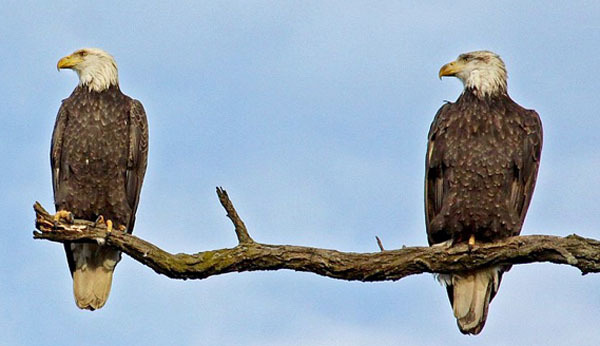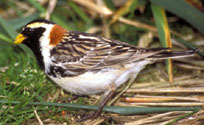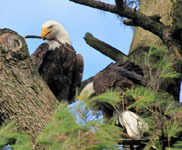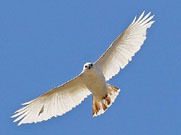Hudson River Almanac 12/08/18 - 12/14/18
The New York State Department of Environmental Conservation sent this bulletin on 12/21/2018 02:00 PM EST |
| DEC Delivers - Information to keep you connected and informed from the NYS Department of Environmental Conservation |
| Share or view as a web page || Update preferences or unsubscribe |
|
Compiled by Tom Lake, Hudson River Estuary Program Consulting NaturalistOverviewJust a week before the solstice, we saw more winter birds from points north, more woolly bear predictions, northern harriers and short-eared owls, and we began what could become a weekly feature in the Almanac: The Fish of the Week! Highlight of the Week
[Lapland longspur (Calcarius lapponicus) is a common songbird that breeds in the Arctic tundra and winters in open fields across much of the northern United States and southern Canada. They show up in small numbers in our area in winter often in the company of the related snow buntings. Tom Lake] Natural History Entries12/8 – Saratoga County, HRM 182: Recently, I have come across half a dozen woolly bear caterpillars with wide brown stripes and very narrow black stripes. None of them were all brown, but all very close. Their decision seems unanimous: Mild winter. 12/8 – Ulster Park, HRM 87: I get a kick out of the woolly bear and winter prediction posts in the Hudson River Almanac. If we are in for a mild winter, it better start soon. It seems to me that it has been like winter for two months already, and it hasn't even officially started. 12/8 – Hudson Valley: On 11/26, the Hudson River Almanac reported on Tom Hall’s 4,000-year-old Indian artifact (a Bare Island projectile point) found near Pine Island in Orange County. Reader David Cornelius asked why that particular point style was not in use before 4,000 years ago. The answer involves the mystery of human predilections in prehistoric times: Why did projectile point types come into vogue, only to be replaced after a few hundred years by newer, but not necessarily better, styles? The answer is almost certainly complex and involves cultural, social, and even spiritual factors. We do not know. David also wondered about the antiquity of humans in the Hudson River Valley. Sites elsewhere in North America, below the reach of Ice Age glaciers, with evidence of human habitation, tentatively date as old as 16,000 years ago. In the Hudson River watershed, the oldest evidence of human presence may be the Davis site, in Essex County, on a strand line of the now extinct Champlain Sea. That site dates to about 13,000 calendar years ago. No evidence has yet surfaced to suggest a pre-Ice Age presence. However, if there had been, it is likely that the broad, deep, and abrasive Laurentide ice sheet that swept over the watershed 20,000 years ago erased most if not all evidence our presence.
We think this is the adult pair from Newburgh’s bald eagle nest NY488. That nest fell in 2018 following the breeding season and is only two blocks away. This pair started showing up last May with two new fledglings in tow that we assumed came from a successful breeding season at NY488. We watched the fledglings learn to land on branches – clumsily to gracefully – and nosily receive food from their parents. As a result, we have had lots of fish bones and pieces of fish on our driveway and our cars. This is great fun, and we look forward to seeing the results this coming season. (Photo of bald eagles courtesy of Dan Tooker)
12/10 – New Baltimore, HRM 131.5: A group of at least eight evening grosbeaks visited my feeders this morning. The blue jays kept kicking them off, and eventually they left the yard. I hope they'll be back. 12/11 – Town of Poughkeepsie: This coming February will be four years since I came upon a new bald eagle nest, later designated as NY372, on the periphery of the City of Poughkeepsie. Since then, the adult pair have had three nesting seasons, none of which were successful, even though it appeared they were doing everything right. The adult pair abandoned the nest April 18, 2018. This fall, a new, and noticeably younger pair, have taken over the nest and seem to be very eager. The male appears to be the older of the two – his head and tail feathers are almost all white – while the female looks like she is just approaching maturity. We have hopes that they will try to breed this spring, and if that proves to be too soon, they will at least establish the nest as theirs. 12/11 – Wappinger Creek, HRM 67.5: During a late-morning low tide, we counted more than a dozen common mergansers and four hooded mergansers in the tidewater reach of Wappinger Creek. Most were drakes. This is one of the signs of impending winter when mergansers and other winter ducks arrive by the many hundreds in the river and its tributaries, one step ahead of frozen-over northern lakes. [Jim Rod, a legendary naturalist for Audubon, used to refer to common mergansers as “eagle food”! Diving ducks, such as mergansers, are often an easy target of bald eagles. Marsh ducks like mallards, black ducks, teal, wigeon, pintails, and wood ducks spring straight up from the water. Diving ducks like mergansers, require a “runway” to get airborne, providing a longer and easier target for eagles in a stoop. Tom Lake] 12/12 – Washington County, HRM 193: Just before midnight at my home in Salem, I was interrupted in calculating school grades by a saw-whet owl doing a grand vocal performance in my backyard. While I have heard them at nearby Merck Forest, I had never heard one at home. The constant “tooting” call was amazing and lasted for a solid half hour. The owl was, by far, my best yard bird ever. I'll take them over Christmas carolers any day! 12/12 – Saratoga County, HRM 182: Inspired by seeing a drake canvasback on Saratoga Lake yesterday, we headed over this afternoon to the same spot. But there was a problem: the cove of the lake was frozen. A couple of open leads farther held Canada geese but not much else. We visited Manning and Riley coves where we found another canvasback as well as tons of common mergansers. In our 19-mile trip around the lake, we totaled 21 species, including 900 Canada geese, 350 common mergansers, 70 hooded mergansers, and 95 common goldeneye. 12/12 – Manhattan, HRM 1: Fish have been scarce recently at Pier 25. So, when we checked our research sampling gear in Hudson River Park at The River Project's sampling station on the lighthouse tender Lilac, we were not surprised that the pots and traps held just crustaceans and a lonely mussel. Among the catch were several dozen shore shrimp, isopods, five sleepy mud crabs, and a blue mussel. (Photo of blue mussel courtesy of NJ-DEP)
*** FISH OF THE WEEK ***
Atlantic needlefish are found in coastal and inshore waters from New England to South America and are known primarily as a temperate to tropical marine species. Their presence in the Hudson River estuary has gone largely unnoticed. In J.R. Greeley’s A Biological Survey of the Lower Hudson Watershed (1937), he considered needlefish rare. He noted that they spawn in salt water even though his survey found immature needlefish as far upriver as Ulster Park (river mile 87). Larval needlefish have recently been captured more than ninety miles upriver in freshwater, and it appears that they are spawning in the estuary. A needlefish oddity occurs when you cook them: they are delicious smoked, and their bones turn Kelly green. (Photo of Atlantic needlefish courtesy of NJ-DEP) [The Atlantic needlefish is number 111 of 228 species on our Hudson River Watershed Fish Fauna list. If you would like an electronic copy, e-mail: trlake7@aol.com. And If you have a favorite fish, let us know. Tom Lake] 12/14 – Galeville, HRM 74: On a visit to the Shawangunk Grassland National Wildlife Refuge today, female northern harriers were dipping and dancing everywhere. As sunset approached, I spotted a female harrier on the ground in a mowed area of the refuge. A few minutes later a “gray ghost” (male northern harrier) drifted down and landed within ten yards of the resting female. The two stayed near each other but never moved closer. They both took off and were joined by a second “gray ghost.” As I left, all three were dipping and diving above the grasses. As darkness fell, I heard the familiar “kee” of a short-eared owl that was followed by a string of vocalizations. Then, two short-eared owls fluttered up and down and circled me as I stood. [The male northern harrier, or marsh hawk, pale with black wing tips, is a light-colored raptor that birders often refer to as the “gray ghost.” Tom Lake] 12/14 – Yonkers, HRM 18: We finally got back in the water today at the Sarah Lawrence College Center for the Urban River at Beczak after a brief hiatus. We made six hauls of our seine and came up empty. Absolutely nothing. Not even a shrimp or a crab! The tide was medium-high, so we seined in the Beczak Marsh. Seeking reasons for the empty net, we considered that the salinity was about zero parts-per-thousand. That is very low for us in the fall. [One of the first points made by graduate school professors in statistics classes, is that no data (zero data points) is still data. Therefore, no haul of an empty seine is ever without value. Tom Lake] Winter 2018 Natural History ProgramsTBA Hudson River Miles DEC's Smartphone app for iPhone and Android is now available at: New York Fishing, Hunting & Wildlife App. Adventure NYUnder Governor Cuomo's Adventure NY initiative, DEC is making strategic investments to expand access to healthy, active outdoor recreation, connect more New Yorkers and visitors to nature and the outdoors, protect natural resources, and boost local economies. This initiative will support the completion of more than 75 projects over the next three years, ranging from improvements to youth camps and environmental education centers to new boat launches, duck blinds, and hiking trails. Read more about the Adventure NY initiative. For more information on planning an outdoor adventure in New York State, visit DEC's website at http://www.dec.ny.gov/outdoor. |

 Hudson River Almanac
Hudson River Almanac 12/10 – Coxsackie, HRM 124: Around noon today, I spotted a Lapland longspur in a group of eight snow buntings in the lawn area of the Coxsackie Grasslands. The group was kicked up by passing truck traffic. (Photo of lapland longspur courtesy of National Fish and Wildlife Service)
12/10 – Coxsackie, HRM 124: Around noon today, I spotted a Lapland longspur in a group of eight snow buntings in the lawn area of the Coxsackie Grasslands. The group was kicked up by passing truck traffic. (Photo of lapland longspur courtesy of National Fish and Wildlife Service) 12/9 – Saratoga County, HRM 166: I was out on the Hudson River photographing bald eagles just below Lock 2 (I found two) and came upon a gorgeous drake green-winged teal (Anas crecca). Green-winged teal breed in Canada and are a relatively common duck in fall migration to wintering areas to our south. They share the genus Anas with other marsh or dabbler ducks, such as mallards, black ducks, gadwall, blue-winged teal, common pintail, American wigeon, and northern shoveler. (Photo of green-winged teal courtesy of Mike Lemery)
12/9 – Saratoga County, HRM 166: I was out on the Hudson River photographing bald eagles just below Lock 2 (I found two) and came upon a gorgeous drake green-winged teal (Anas crecca). Green-winged teal breed in Canada and are a relatively common duck in fall migration to wintering areas to our south. They share the genus Anas with other marsh or dabbler ducks, such as mallards, black ducks, gadwall, blue-winged teal, common pintail, American wigeon, and northern shoveler. (Photo of green-winged teal courtesy of Mike Lemery) 12/9 – Newburgh, HRM 61: A pair of bald eagles have been building a nest in a big white pine in our yard in the City of Newburgh. Nest building is a messy and apparently haphazard affair with missed placements followed by tossing out sticks that did not meet their satisfaction.
12/9 – Newburgh, HRM 61: A pair of bald eagles have been building a nest in a big white pine in our yard in the City of Newburgh. Nest building is a messy and apparently haphazard affair with missed placements followed by tossing out sticks that did not meet their satisfaction. 12/9 – Westchester County, HRM 34: I reported sighting a huge bobcat at Pound Ridge a week ago and added that big cats are rare and a very special treat. In case we forget just how special they are, they mark up our beech trees (soft bark), honing their claws, to remind us they are around. (Photo of bobcat scratches on beech tree courtesy of Mike Byrne)
12/9 – Westchester County, HRM 34: I reported sighting a huge bobcat at Pound Ridge a week ago and added that big cats are rare and a very special treat. In case we forget just how special they are, they mark up our beech trees (soft bark), honing their claws, to remind us they are around. (Photo of bobcat scratches on beech tree courtesy of Mike Byrne) 12/13 – Fort Edward to Fort Miller, HRM 202-192: I drove up along the Hudson River where the numbers of common goldeneye were beginning to increase. I found a lingering common loon at Fort Miller. While the Fort Edward Grasslands were not particularly productive, I did spot a northern harrier, one each of dark-phase and light-phase rough-legged hawks, and an American kestrel. As I was heading back down Route 4, a large white bird flew across into the fields. I thought it might be a snowy owl, but when I looked again, I saw that it was an albino red-tailed hawk! (Photo of albino red-tailed hawk)
12/13 – Fort Edward to Fort Miller, HRM 202-192: I drove up along the Hudson River where the numbers of common goldeneye were beginning to increase. I found a lingering common loon at Fort Miller. While the Fort Edward Grasslands were not particularly productive, I did spot a northern harrier, one each of dark-phase and light-phase rough-legged hawks, and an American kestrel. As I was heading back down Route 4, a large white bird flew across into the fields. I thought it might be a snowy owl, but when I looked again, I saw that it was an albino red-tailed hawk! (Photo of albino red-tailed hawk) 12/13 – Hudson River Estuary: Natural selection designed the Atlantic needlefish to be the consummate predator. They are sight-feeders, with more than 20% of their adult length taken up by slender tooth-studded jaws. A ventrally-adjusted lateral-line allows needlefish to drift on the surface, hunt for prey, and still maintain an air-water interface. Adults can reach nearly two-feet in length and will frequently leap out of the water in pursuit of prey.
12/13 – Hudson River Estuary: Natural selection designed the Atlantic needlefish to be the consummate predator. They are sight-feeders, with more than 20% of their adult length taken up by slender tooth-studded jaws. A ventrally-adjusted lateral-line allows needlefish to drift on the surface, hunt for prey, and still maintain an air-water interface. Adults can reach nearly two-feet in length and will frequently leap out of the water in pursuit of prey.